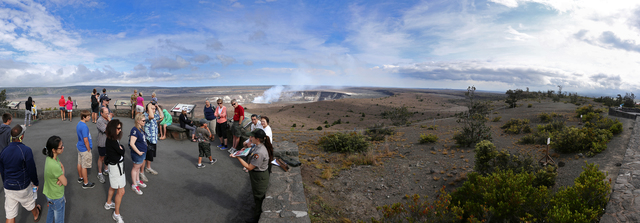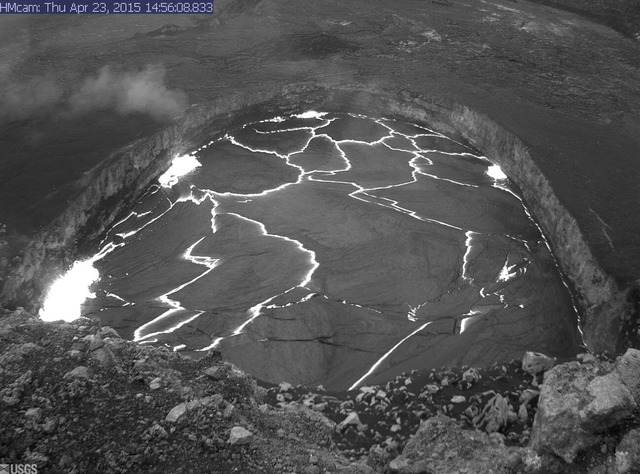The lava lake in Halemaumau at Kilauea’s summit could be visible from the edge of the caldera as early as today if it continues to rise, geologists say.
The lava lake in Halemaumau at Kilauea’s summit could be visible from the edge of the caldera as early as today if it continues to rise, geologists say.
The lake, which rises and falls during periods of inflationary or deflationary tilt, reached new heights Thursday afternoon when it was less than 70 feet from the crater floor, surpassing the last record from October 2012 by more than 2 feet.
Steve Brantley, deputy scientist-in-charge at Hawaiian Volcano Observatory, estimated a portion of the lake could be visible from Jaggar Museum if it climbs another 10 feet.
“If it keeps rising at the same rate maybe within a day one part of the lava lake might be visible but not the whole thing,” he said Thursday.
“You might be able to see one corner of it.”
Spattering was visible at the south edge of the lake and the high level of the lake triggered small collapses in the crater wall. An increase in earthquake activity at the summit also was detected.
Brantley said sharp cracking sounds could be heard from rocks on the crater wall bursting due to the intense heat.
He said the lake could begin to drop with little notice.
“It could just as easily, instead of continuing to rise, the inflation could stop and we might enter into a deflation episode and the lava lake would then be expected to drop again,” Brantley said.
“We’ll see how lava (activity) continues to unfold over the next one or two days.”
The lake formed during an explosive eruption on March 19, 2008.
Down the volcano’s East Rift Zone, the June 27 lava flow appeared to remain within 5 miles of the Pu‘u ‘O‘o vent this week, geologists said.
Janet Babb, HVO spokeswoman, said data from an overflight Thursday was still being analyzed that afternoon but there appeared to be little overall change in activity.
Surface activity has been limited to three breakouts, and the lower reaches of the flow have remained inactive since mid-March.
Brantley said there appears to be little chance that the tube downslope of the breakouts will be reoccupied.
He said flows from the breakouts have made little progress due to the area’s gentle topography and a below average eruption rate.
About 100,000 to 200,000 cubic meters of lava is flowing to the breakouts a day.
That’s below the average of 350,000 cubic meters a day for the 32-year Pu‘u ‘O‘o eruption.
At this rate, it would take months or years for the flow to reach Puna communities, he said. But that could change if the flow becomes more concentrated or if the lava output increases.
Darryl Oliveira, Hawaii County Civil Defense administrator, said the flow remains a concern.
“Until the eruption actually stops or happens to take a different direction that doesn’t appear to pose any threat to the community, we are going to maintain our heightened level of awareness and concern,” he said.
Oliveira said the county still plans to hold another community meeting in Pahoa to discuss the lava flow and federal reimbursement for costs associated with lava mitigation.
Email Tom Callis at tcallis@hawaiitribune-herald.com.


